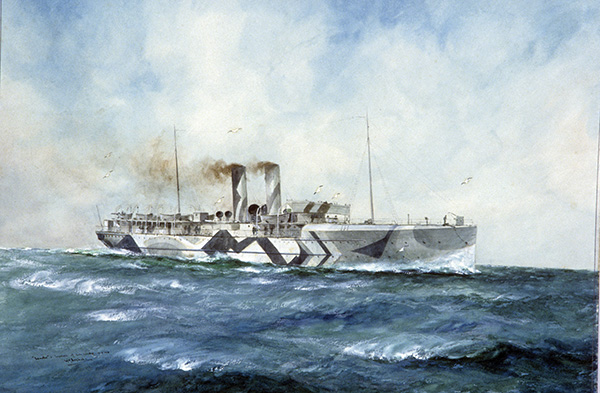100 YEARS AGO: RMS Leinster sunk
Published in Issue 5 (September/October 2018), Volume 26By Joseph E.A. Connell Jr

Above: A camouflaged RMS Leinster as she would have appeared at the time of her sinking. (Michael Charles/Mercantile Marine Memorial Collection)
In 1895 the City of Dublin Steam Packet Company ordered four steamers for Royal Mail service, named for the four provinces of Ireland: RMS Leinster, Munster, Connaught and Ulster. These four were commonly referred to as ‘the provinces’.
The Leinster was a 2,640-ton packet steamship with a service speed of 24 knots. The vessel, which was built in Laird’s in Birkenhead, England, was driven by a single eight-cylinder triple-expansion steam engine. During the First World War the twin-propellered ship was armed with one twelve-pounder and two signal guns.
Shortly before 9am on 10 October 1918 the RMS Leinster left Carlisle Pier, Kingstown (now Dún Laoghaire), bound for Holyhead. The ship’s log stated that she carried 77 crew and 694 passengers. Captain William Birch (61), a Dubliner who had settled with his family in Holyhead, was in command. Apart from Birch, the Leinster had a crew of 76, drawn from the ports of Kingstown and Holyhead. Also on board were 22 sorters from the Dublin Post Office, working in the ship’s on-board postal sorting room. There were 180 civilian passengers, men, women and children, most of them from Ireland and Britain.
By far the greatest number of passengers on board the Leinster, however, were military personnel. Many of them were going on or returning from leave. They came from Ireland, Britain, Canada, the United States, New Zealand and Australia. There were almost 500 military personnel from the British Army, the Royal Navy and the Royal Air Force. Also aboard were nurses from Britain, Ireland, Australia, New Zealand, Canada and the United States. At the time, the war was turning in the Allies’ favour and on the Western Front the German Army was being pushed back by the relentless assaults of the Allied armies. On 4 October Germany had asked the US president, Woodrow Wilson, for peace terms.
As the Leinster set sail the weather was fine, but the sea was rough following recent storms. Earlier that morning a number of Royal Navy ships at sea off Holyhead were forced to return to port owing to the stormy conditions. Just before 10am, as the Leinster was sailing east of the Kish Bank in a heavy swell, passengers saw a torpedo approach from the port side and pass in front of the bow. A second torpedo followed shortly afterwards, and it struck the ship forward on the port side in the vicinity of the mail room. Captain Birch ordered the ship to make a U-turn in an attempt to return to Kingstown, as she began to settle slowly by the bow. The Leinster sank rapidly, however, after a third torpedo struck her, causing a huge explosion. Despite the heavy seas, the crew managed to launch several lifeboats and some passengers clung to life-rafts. The survivors were rescued by HMS Lively, HMS Mallard and HMS Seal. Another of the rescue ships was armed yacht and former fishery protection vessel HMY Helga (of 1916 fame).
The first member of the Women’s Royal Navy Service to die on active duty, Josephine Carr, was among those killed, as was Captain Birch. Wounded in the initial attack, he was drowned when his lifeboat became swamped in heavy seas and capsized while trying to transfer survivors to HMS Lively. Several of the military personnel who died are buried in Dublin’s Grangegorman military cemetery.
The U-boat that fired the torpedoes, UB-123, was probably lost in a minefield in the North Sea on her way back to Germany, on or about 19 October 1918. The bodies of her commander, Oberleutnant zur See Robert Ramm, and his crew of two officers and 33 men were never recovered.
Joseph E.A. Connell is the author of Michael Collins: Dublin 1916–22 (Wordwell Books).
















